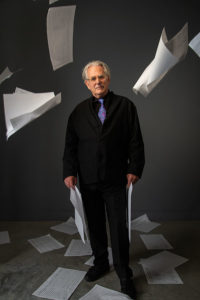Lawrence Sieberth is back at it again with two new exciting projects. The New Orleans-based composer, pianist and producer reimagines Tchaikovsky’s The Nutcracker with an original jazz score for a dance production commissioned by the Marigny Opera Ballet. The performance will be staged from December 3-5 and 10-12 at the Marigny Opera House. In this world-premiere version of the dreamy holiday tale, a young girl is transported from Jackson Square in New Orleans on Christmas Eve to the Kingdom of Rain and the Kingdom of Sweets, and then back again to her bench in front of St. Louis Cathedral.
Earlier this year on October 15, Sieberth released a new album, Musique Visuelle. This fusion of jazz and classical music embraces a variety of global cultures. The album makes evident that Sieberth is a musical alchemist at play and at work in a creative laboratory all his own. The result is a project that confidently blurs the confines of comfortable categories.
OffBeat contributing writer Bailey Whitley spoke with Sieberth about both of these imaginative musical endeavors.
As you know, Duke Ellington composed a jazz interpretation of The Nutcracker in 1960, entitled the Nutcracker Suite. Did you find inspiration from his composition or did you solely use the original by Tchaikovsky as guidance?
I played parts of Duke Ellington’s version of that a long time ago and I purposely didn’t listen to it when I was asked to do the new version of this, because it would be so easy to be influenced by Duke Ellington. One major difference is that my version is a version of 19 of the 25 or 30 compositions written by Tchaikovsky as the underscoring of a dance company, whereas Duke Ellington’s was a musical suite.
I do feel that some of the interpretations of adaptations of what I created from Tchaikovsky’s music could be extrapolated or opened to create musical versions that were not being danced to. I definitely know that music has to inspire movement as opposed to inspire a musical listener and there is a difference for sure. This is why there are great ballets and great music that is not written for ballets. It’s a different animal.
Did you collaborate with Jarina Carvalho, the choreographer from the Marigny Opera Ballet?
Certainly the whole thing is a collaboration. As far as Jarina and I, I would often center an idea on what I’m thinking and she would nine times out of 10 say, “Oh yeah, love it, just do it,” or sometimes she would say “it needs to be a little slower.” There was one time where she asked me to change it because it was referencing tango too much, so we kind of softened it up a bit. It’s been a very enjoyable collaboration. I was feeding Jarina mp3s created on my computer of what the songs were going to sound like and their accurate models sounded a little lifeless because they were done with a computer. Still, all and all, it was more than enough to get her choreography going and I was so impressed with her. The choreography was just wonderful, I couldn’t be more happier about it.
Some might say that what you’re doing is, for a lack of better words, unconventional in nature. Did you face any internal or external criticisms throughout the process or even now?
Well, I had done a piece for the Marigny Opera House before with another amazing choreographer. That was a Christmas show as well, but it had no foundation other than what I was going to create, and so what I tried to do was to make it a story about Christmas in Brazil, because Christmas in Brazil is actually summertime. I used a lot of Brazilian rhythms but intertwined the original music with very common Christmas melodies, so the audience’s perception of songs they heard a billion times was kind of set in a way they couldn’t quite pinpoint. I’ve had people come up to me and say, “What was that song?,” and the song would be “Have Yourself a Merry Little Chrismas.” I wanted to give the listener who is very familiar with the music that Tchaikovsky had written the opportunity to hopefully be amazed by his melodic material and conceptual thinking. There was a lot of landscape for me to choose from, combined with having played music from the last 100 years of the New Orleans vocabulary—the repertoire, I should say.
How long did the process from writing to production take for The Nutcracker?
The first time that I was approached about this project was in 2020. We were supposed to perform in December of last year, but then the pandemic hit in March. I had already written two movements, but I just put them aside until the beginning of this year. If you think you have eight months of work time before a performance you think, “Oh man, I could take my time,” but, of course, there becomes this panic. I had to change composing and finishing the notational scores, which although the computers helped a lot, it wasn’t as easy as pressing a button because I created audio models of a song. It doesn’t necessarily translate to written notes—which is a lengthy process in itself—and does require a lot of thought as to how the notes are to be played and how to notate the way the articulation should be handled.
Who were your inspirations growing up and the people whom you feel shaped you into the musician and composer you are today?
There have been so many things in my life that have influenced me but I can name some of the direct influences that I feel come through in this music. They’re everything from Lalo Schifrin to Thelonious Monk to tangos and Brazilian sambas—not only people I’ve listened to, but people I’ve performed with. I am so appreciative of all the musicians that have come into my life throughout the course of my career who have contributed to the music’s execution, as well as sharing their vision of what my music could be, and who understand what my vision of the music is.
Music is so much more than writing notes and giving people directions. It’s about collaborating and the creation of a piece of music that will be unique to that moment. That’s what’s so special about being a musician who composes, improvises, and understands the importance of each person’s contribution to a project.
When coming up with the premise of Musique Visuelle, was the mix of cultures intentional?
The hardest part for any musician, composer, or anyone involved in almost any creative endeavor is to have a voice that is unique. For me, I never tried to pigeonhole myself into an idiom or any style or any era. I’ve been amazed at how much differentiation there is in the world of music. Whether it be Bach or Jimi Hendrix or The Beatles, the list goes on and on and on. I acknowledge my inspirations but I’m trying to come out with something that’s unique, something that somebody can say, “Oh, that’s Larry.” The other thing you might want to think about when you’re as enthralled with so many cultures as I am—Cuban, Spanish, Japanese, American blues—is that you can’t be a master at all of them, but you can assimilate whatever you appreciate. The more you appreciate, the more you assimilate, and then your color palette grows.
What message do you hope audiences take away from listening to Musique Visuelle?
My intention is for other people to understand something more about me but to also understand the creative process. This is an example of the creative process that everyone should allow themselves to be part of because the creative process is part of almost everything. Every physical object that man has created has been a part of a creative process. There’s a certain joy and respect, and a spiritual awakening and growth that happens when you involve yourself in any creative pursuit. That’s why people do it. It’s not so that I can record another piece of music, it’s so that I can manifest something that I’ve never manifested before. I’m trying to share a manifestation that I’ve gone through in hopes that it might inspire them to do the same with their life.
The Marigny Opera House is located at 725 St. Ferdinand Street. For more information and to purchase tickets, visit here. To watch videos of Lawrence Sieberth in concert, visit his website.





